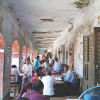Children should feel safe in their schools

It is alarming to learn that about 21 percent of government primary schools in Barguna are in dilapidated conditions, putting the lives of children at risk. According to a report, these schools, built between 1994 and 2002, have never gone through any renovations since, adding to the wear and tear of the structures in a region that often experiences extreme weather events such as cyclones and heavy rain. Take Gaurichanna High School for example, whose students are attending classes in a building declared unsafe two years ago. Teachers say they have urged higher authorities to take steps, but none have been taken so far. Requests for renovations may take some time to process because of bureaucratic complications, but a two-year waiting time for the work to even start is unacceptable.
We have seen a similar situation in many other schools across the country. In June last year, the then state minister for primary and mass education told parliament that a total of 6,704 government primary schools were in dilapidated conditions. It means the many thousands of students, teachers and staff members who visit these buildings every day are at risk. Some guardians are, therefore, reluctant to send their children to schools. Forced academic interruptions like this may harm not only children's education, but also their life potential and future trajectory, especially for rural girl children for whom early marriage is a constant threat.
While the government has plans to replace some of the old, rundown buildings—reconstructing them as cyclone shelters in some cases—students and teachers should not have to risk their lives by continuing to attend classes there. There must be an alternative option that is safer, if temporary. Bureaucratic red tape and procedural delays must not come in the way to compromise their safety and security. Also, during the renovation or construction of buildings, fire/building safety and seismic resilience should also be ensured. Children should be able to focus only on their studies, and not worry whether the place where they are supposed to be protected will come crumbling down.


 For all latest news, follow The Daily Star's Google News channel.
For all latest news, follow The Daily Star's Google News channel. 








Comments